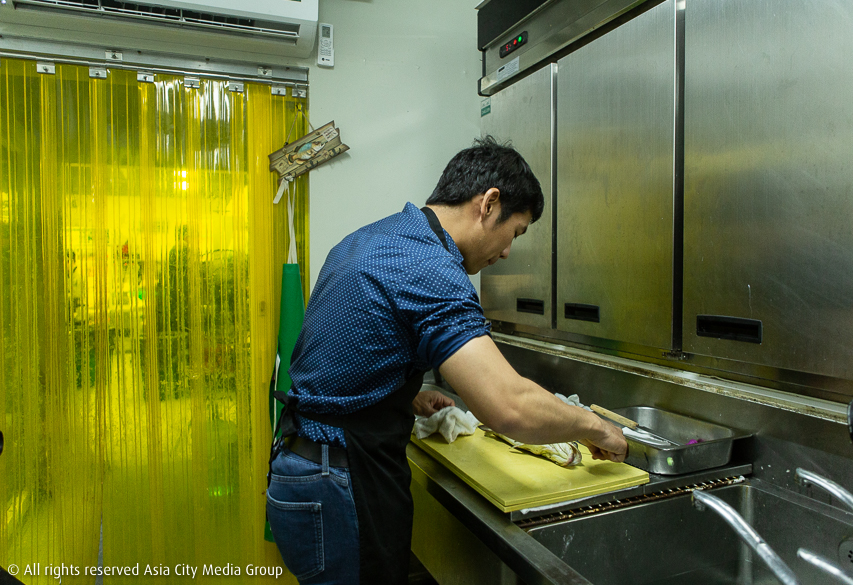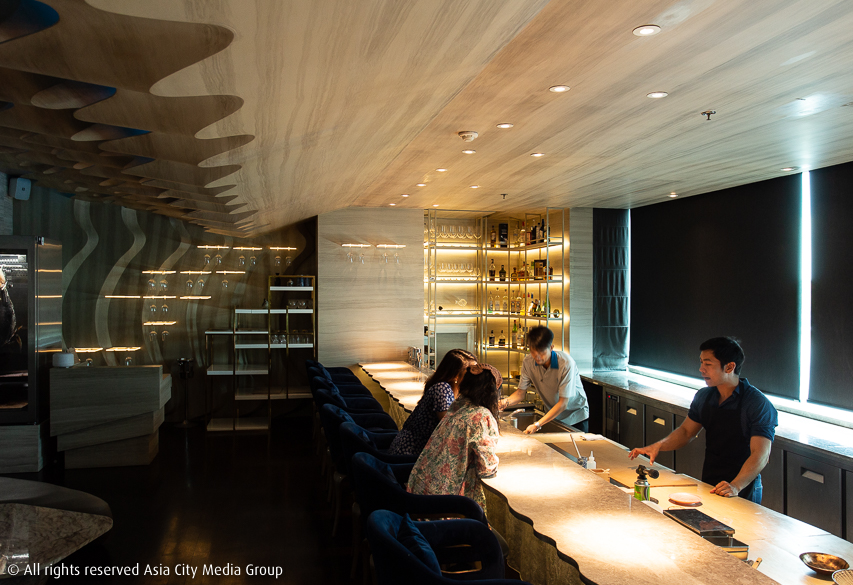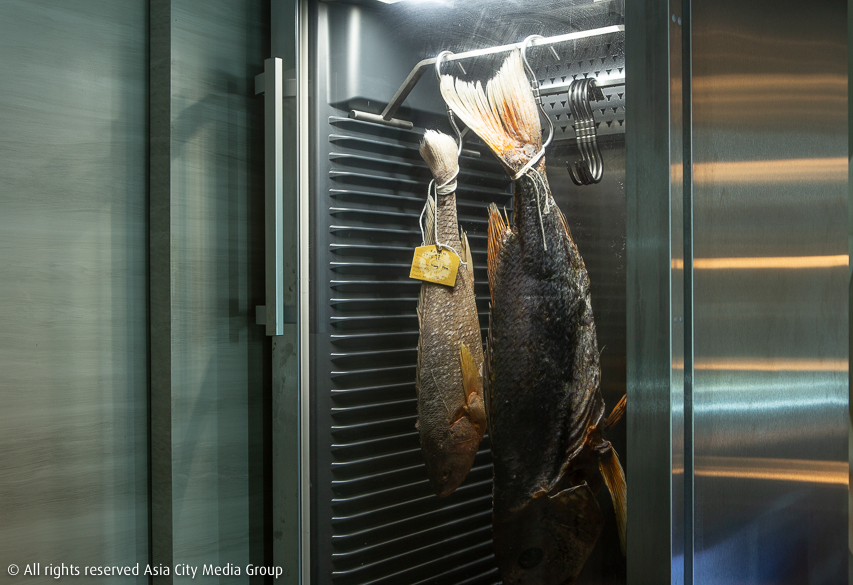Meet the chef serving fish he catches outside Bangkok as omakase sushi
Exploring the secrets of Nonthaburi’s Japanese chef’s table dedicated to Thai seafood.
Located around 15 kilometers north of central Bangkok, the gated community of Nichada Thani is a little slice of wealthy, American-style suburbia known for its luxury homes and international school set around a scenic 125-rai lake. Recently, foodies have found a new reason to make the 30-40-minute ride here, and that’s Kaijin, a mysterious sushi bar preaching a “sea to table” concept.
This chef’s table by Natakorn “Tum” Changrew takes some finding, tucked away as it is in the sprawling, lakeside Vapor restaurant. You step through a glass door into a closet-sized room where lapping waves projected onto the wall give the feeling of being underwater, before another sliding door deposits you before a sleek marble sushi bar that seats only 12. Gentle curves awash in a golden glow create a calming environment in which to enjoy an omakase-style meal.
What differentiates Kaijin from the wave of Japanese sushi imports touting market-fresh produce from the homeland is a focus almost entirely on fish caught in Thailand's waters. Not only that, but Tum and his team journey out to sea on an almost weekly basis to bring back a haul of hook-caught fish, where the aim is quality over quantity.
“My initial intention was to showcase produce from the sea, not just Thailand, that’s been carefully caught and kept in a proper, well-cared-after manner—to show how much better it tastes this way,” Tum said. To get a better grasp of what he means, we spent a day following him to experience the whole process leading up to when the delicate, minimal bites arrive at the table.
Unfortunately, due to a wild storm, we couldn’t follow Tum out to sea—typically he journeys to Pranburi, Chumphon and Phuket—but he did give us a tour of Nichada Thani’s vast lake to see huge specimens like Mekong giant catfish and hi-fin paroon sharks. In addition, he showed us the restaurant's many fish tanks full of fruits of the sea like sweetlips fish and mantis shrimp.
Tum explained that Kaijin employs the ikejime method of slaughtering fish, an age-old Japanese tradition aimed at preserving texture and flavor. Demonstrating on a coral trout, he begins the process by inserting a spike directly into the fish’s hindbrain. This would usually happen as soon as a fish is caught. The action is completed quickly and painlessly in order to prevent the fish from releasing lactic acid throughout its body in times of stress or pain, which can result in a sour and “fishy” taste. Another cut severs the spinal cord, paralyzing the fish. After that, the fish is left to bleed out in ice-cold water to prevent bacteria from growing.

Part of the appeal of dining at Kaijin is that there’s never a set menu. When it comes to ingredients, it’s luck of the draw. Cooking techniques also draw heavily on the whims of nature. For B2,500 per head, you get a 13-17 course meal that flits between fresh seafood and other dishes that have been put through an aging process to add another dimension of flavor.
Should the week’s catch prove unsatisfactory, Tum says they are happy to be flexible. "We don’t push our agenda of having to use only fish caught from Thai seas. We don’t compromise on quality, so should the need arise we’ll order sashimi-grade fish from the Japanese market.”
It’s not only when it comes to fish that Kaijin shoots for self-sustainability. The restaurant's own 17,600-sq-meter garden at the far end of the Nichada Thani village grows everything from house-staple vegetables to edible flowers, which also get put to use on the Vapor menu.

Back in the restaurant, Thai-American sushi chef Niki Vongthong presides over the sushi counter to carefully roll out innovative sushi bites. The mains and appetizers, devised by Tum with the help of his kitchen team, almost all come with Thai twists—sweetlip fish in a subtle yuzu buttermilk broth that’s cut nicely by refreshing orange slices and the glassy taste of kampot oil; five-day-aged hang kew (croaker fish) served roasting inside a mound of hay with pickled bittermelon and nikiri; fresh slices of grouper topped with caviar, crispy mung beans and culantro sanbaizu oil.
To go with, Tum himself shakes up glass after glass of similarly forward-looking cocktails. Primed with bartender experience from his now-closed Perfume bar in Thonglor, he whips out signatures like the Yuzu Mojito (B300), made with Lanna Thai rice spirit and liquid nitrogen mint leaves, which he says are not as bitter as their freshly smashed counterparts. The drink’s topped off with lightly-torched jasmine meringue and colorful smashed hibiscus flowers that’ve been frozen in, again, liquid nitrogen.

If that all sounds quite experimental, that’s probably because Kaijin is very much a work in progress. “Right now, the restaurant only opens three days a week [Fri-Sun]. The rest of the time we’re in our lab brainstorming new ways to extract the most flavor out of the fish we’ve caught. We want to maintain a high quality of food while taking small steps in improving our service. We’re fairly new and want to get things right."
If you’re seeking a dining experience that’s novel yet not at all pretentious, Kaijin ticks the boxes. Tum's uncompromising dedication to local ingredients is not only inspiring, but goes some way to proving that Thai- land’s seafood can be every bit as desirable as those expensive imports.
Kaijin, 39/1257 Samakkee Rd., Nichada Thani, 02-004-8127. Open Fri-Sun 6pm-midnight. www.fb.com/kaijinbangkok

Advertisement